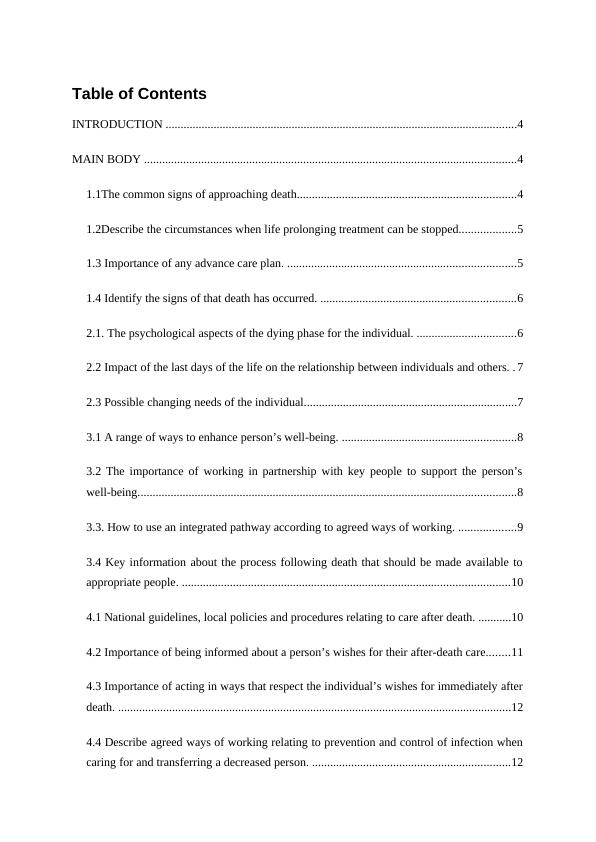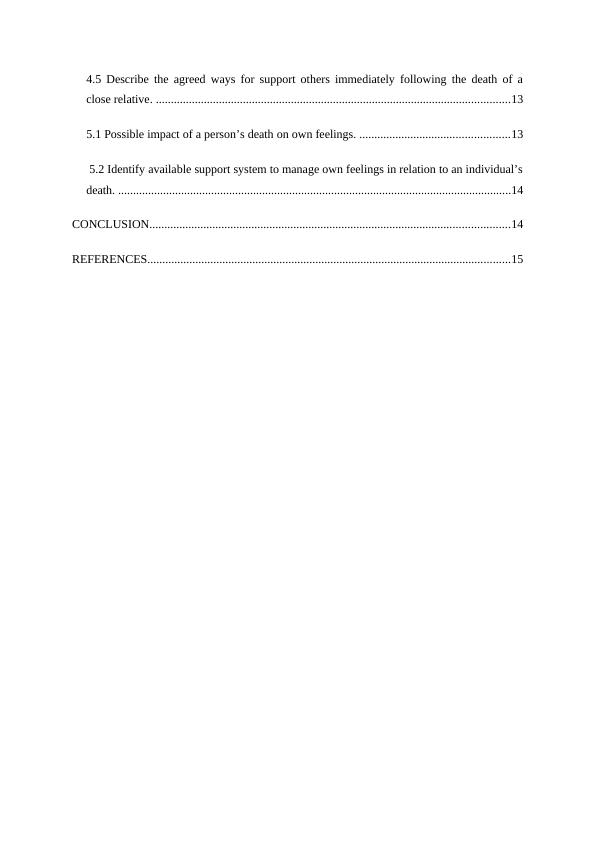(PDF) End of Life Care and Decision Making
15 Pages5074 Words102 Views
Added on 2021-01-02
(PDF) End of Life Care and Decision Making
Added on 2021-01-02
ShareRelated Documents
UNIT 73: is your unit aroundunderstanding how to support peopleduring the last days of life

Table of ContentsINTRODUCTION .....................................................................................................................4MAIN BODY ............................................................................................................................41.1The common signs of approaching death.........................................................................41.2Describe the circumstances when life prolonging treatment can be stopped...................51.3 Importance of any advance care plan. ............................................................................51.4 Identify the signs of that death has occurred. .................................................................62.1. The psychological aspects of the dying phase for the individual. .................................62.2 Impact of the last days of the life on the relationship between individuals and others. .72.3 Possible changing needs of the individual.......................................................................73.1 A range of ways to enhance person’s well-being. ..........................................................83.2 The importance of working in partnership with key people to support the person’swell-being..............................................................................................................................83.3. How to use an integrated pathway according to agreed ways of working. ...................93.4 Key information about the process following death that should be made available toappropriate people. .............................................................................................................104.1 National guidelines, local policies and procedures relating to care after death. ...........104.2 Importance of being informed about a person’s wishes for their after-death care........114.3 Importance of acting in ways that respect the individual’s wishes for immediately afterdeath. ...................................................................................................................................124.4 Describe agreed ways of working relating to prevention and control of infection whencaring for and transferring a decreased person. ..................................................................12

4.5 Describe the agreed ways for support others immediately following the death of aclose relative. ......................................................................................................................135.1 Possible impact of a person’s death on own feelings. ..................................................135.2 Identify available support system to manage own feelings in relation to an individual’sdeath. ...................................................................................................................................14CONCLUSION........................................................................................................................14REFERENCES.........................................................................................................................15

INTRODUCTION The last few days of an individual’s life is also known as terminal case, or the dyingphase. Everyone in this world experience this phase of dying in different ways and it isdifficult to know when a person is reaching the last few days of their life. Further, it has beendetermined that the last stages of a persona’s life can be very stressful and also for those whoare caring for him/her. In these cases, responsibilities of a service provider may vary based onwhere the person with any dying disease is receiving care or not. This report is based onunderstanding how to support individuals during the last days of life. This will cover,common signs of approaching death, circumstances when life-prolonging treatment can bestopped and impact of the last days of life on the relationships between individual and others.Apart from this it will also explain the importance of working in partnership with the keypeople to support the individual’s wellbeing including the importance of beingknowledgeable about a person’s wishes for their after death care. Lastly it will describe waysto support others immediately following the death of a close relative or friend and importanceof any advance care plan in the last days of life. MAIN BODY The common signs of approaching death.The following are the common signs of approaching death:Coolness :- if a person’s hands, legs, arms and feet increasingly gets cool to the touchand the colour of their skin may alter and become mottled. These are signs ofapproaching death. In elderly adult, their skin can become paper thin and pale withdark liver spots appearing on hands, feet and face as well (Ahmedzai, 2018). Decreased blood perfusion :- in this case skin becomes mottled and discoloured.Mottling & cyanosis of the upper edges seem to show awaiting death versus such aschanges in the lower extremities. Eating an drinking less :- as people become older, their energy needs decreases. Thereason behind this is an individual does not need as much energy as to carry out dailywork, food and drinks seems less necessary. People who are close to death may noteven be interested in some of their favourite food also.

End of preview
Want to access all the pages? Upload your documents or become a member.
Related Documents
Understanding How to Support Individuals During the Last Days of Lifelg...
|12
|3732
|89
Support individuals in the communitylg...
|35
|8449
|305
Attitudes Towards Death and Determining Deathlg...
|7
|1726
|332
Legislative Worksheet Sbar Format Reportlg...
|5
|1089
|21
Nursing and Ethics - The palliative carelg...
|6
|1735
|46
(PDF) End-of-life issues for aboriginal patientslg...
|6
|1593
|232
